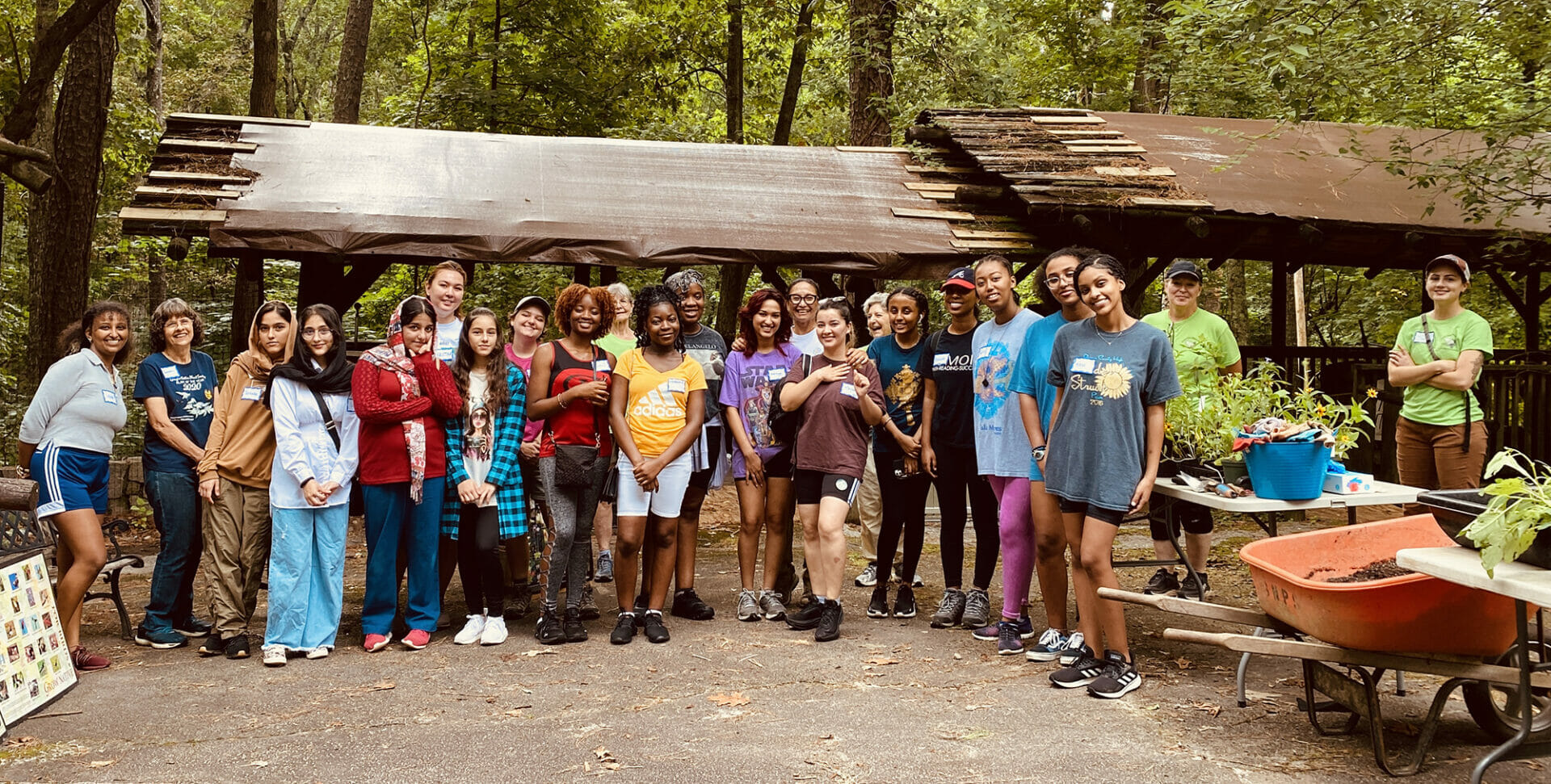
Read about this fine group of new native plant enthusiasts in our lead article.
In This Issue ...
- Refugee Women's Network at SMPP
- It's time to count pollinators again
- Spotlight on jewelweed
- Chapter News
Reaching out to Refugee Youth
Kim Mallett
The Stone Mountain Propagation Project recently partnered with the Refugee Women’s Network (RWN) to host a group of young women, ages 14-18, for a visit to Stone Mountain. The RWN is a Clarkston-based organization that assists refugees who resettled in Georgia; their mission is to inspire and equip refugee and immigrant women to become leaders in their homes, businesses, and communities. Our event was the first in the Wellness branch of their new female youth program. We were excited to welcome visitors from a variety of countries, including Ethiopia, Eritrea, the Democratic Republic of Congo, and Afghanistan. Fortunately, language was not a barrier to communication as most of the girls have attended school in Georgia for a while.
We planned a two-part program: 1) a hands-on experience creating a native plant container garden to take home and 2) a hike on one of the trails in Stone Mountain Park. Barbara Dorfman gave a short talk on pollinators, bees, and butterflies, explaining the importance of planting and nurturing native plants to give pollinators a place to lay their eggs and to find nectar. She touched on how native plants and insects have coevolved and the danger to our ecosystem when invasives crowd out native plants.
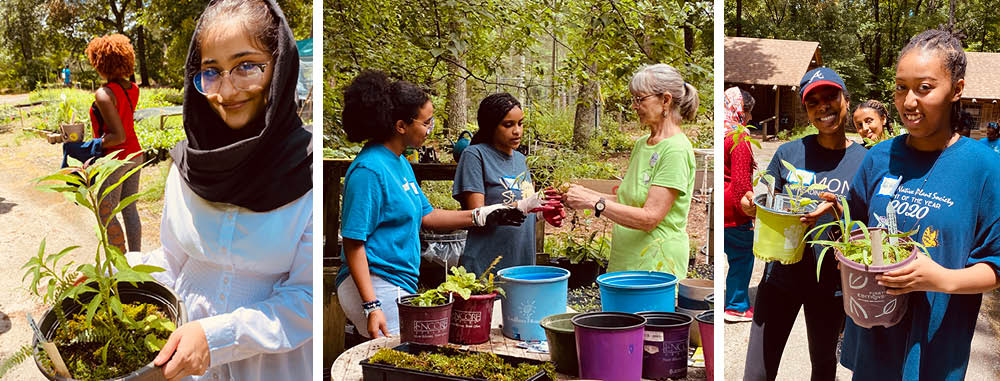
Left and right: RWN youth proudly display their container gardens. Center: Kim Mallett shows the girls how to gently prepare a plant for transplanting to a container garden.
We had pre-gathered a collection of pots in a variety of colors and staged plants that could coexist, dividing them into the categories of sun versus shade. We encouraged them to think about where in their homes or yards they would place the pots and to choose plants accordingly. The girls were eager to dig in and get their hands dirty. They came up with many beautiful and interesting combinations, keenly aware of aesthetics in creating their arrangements. For sun, we offered black-eyed Susans, wild petunia, and Stone Mountain daisies. The pots destined for shade focused on foamflower, ebony spleenwort, and mosses. Barbara reminded them that most of the plants were perennials and that they should not despair when they seemed to be dying. They were encouraged to continue watering during the winter so their native perennials would bloom again next spring.
Conversation with the girls revealed that many of them are taking classes in ecology and environmental science. They were excited to gain first-hand experience working with native plants, and they hoped to observe pollinators choosing their plants as nectar sources or egg-laying destinations. Several said they needed volunteering credit for school organizations and expressed interest in returning to volunteer with us.
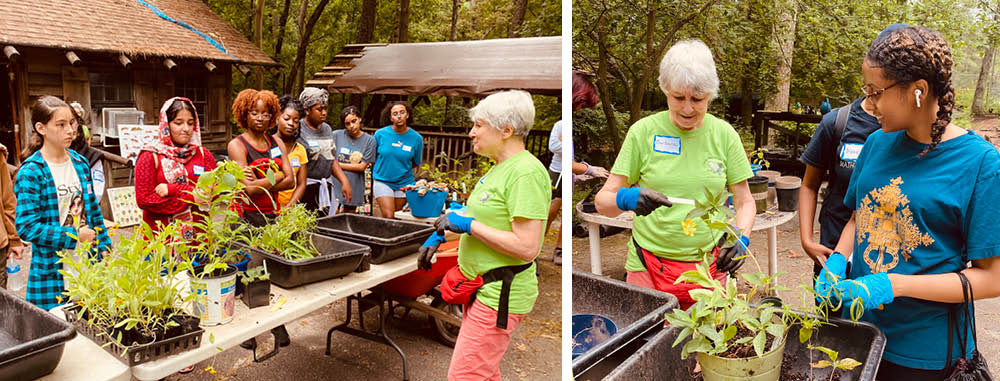
Left: Barbara Dorfman explains the difference between sun and shade plants. Right: Barbara helps a young woman select plants for her container garden.
After a full morning of up-potting and plant/pollinator discussions, our adolescent cohorts were still full of energy and enthusiasm for a hike, despite the humid July heat. From the Grist Mill parking lot, we hiked to the Covered Bridge, around the island and back. We maintained a vigorous hiking pace, pausing a few times to discuss sites of interest, including a spot where I had seen and photographed an Eastern King snake the previous week. Since the snake, perhaps wisely, decided not to make an appearance, I showed them my cell phone photo. We explained that encounters with venomous snakes are rare here and that most snakes provide beneficial free pest control by eating mice, rats, and even copperheads. Our Stone Mountain Park guide pointed out a large Eastern hemlock and explained that, while this species generally is threatened by the Hemlock woolly adelgid, this tree is flourishing perhaps since our climate is hotter than preferred by the adelgid pest. Back at the Grist Mill picnic area, our guide also pointed out a Champion Eastern red cedar.
Before returning to the propagation area to retrieve their pots, the girls enjoyed a picnic lunch and a chance to rest their feet. The RWN leader asked for their impressions of the day. Enthusiasm was universal. Most of the girls had heard of Stone Mountain but had never visited the park. Many were excited to return in fall see the Stone Mountain yellow daisies and perhaps to visit or volunteer with us. We hope we have planted seeds of interest in and appreciation for native plants in members of a younger generation.
The Great Georgia Pollinator Census Is back!
For the sixth consecutive year (including two pilot study years), a large citizen science program, the Great Georgia Pollinator Census, is being held in August. Organized by project coordinator Becky Griffin of the University of Georgia Extension, the census has goals of increasing pollinator habitat, increasing citizen literacy, and generating scientific data about pollinator populations. It only takes fifteen minutes to contribute to the project, and you do not need to be an insect expert or even a plant expert. Downloadable materials will get you started in no time. But you do have to be ready to count on either August 19th or 20th, so download the guide and counting sheet, and pick out a favorite plant to watch.
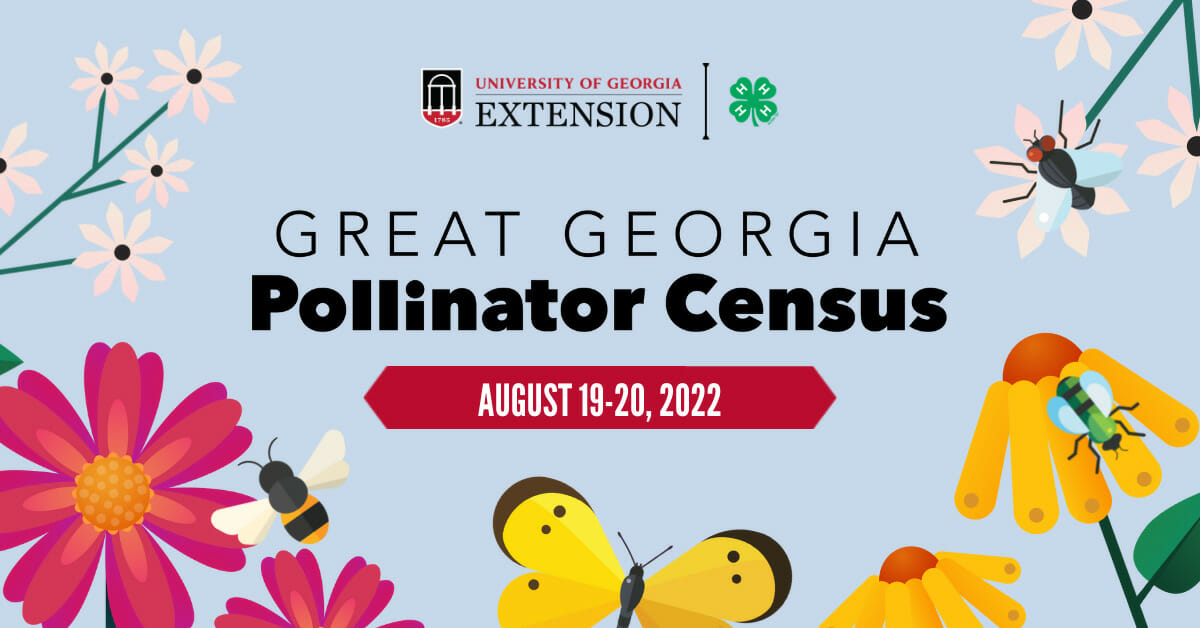
Counting is easily done alone, but for those of you who are interested in participating in a social event, or possibly coordinating an event yourself, check out the census counting events at the GGAPC site. Watch for news from your affiliated GNPS chapter about any local counting events, too, including those mentioned in Chapter News below. And for anyone interested in an in-depth paper about the project, see The Strategic Use of Multimedia in the Great Georgia Pollinator Census Citizen Science Project.
Jewelweed – a Summer Native Annual
Ellen Honeycutt
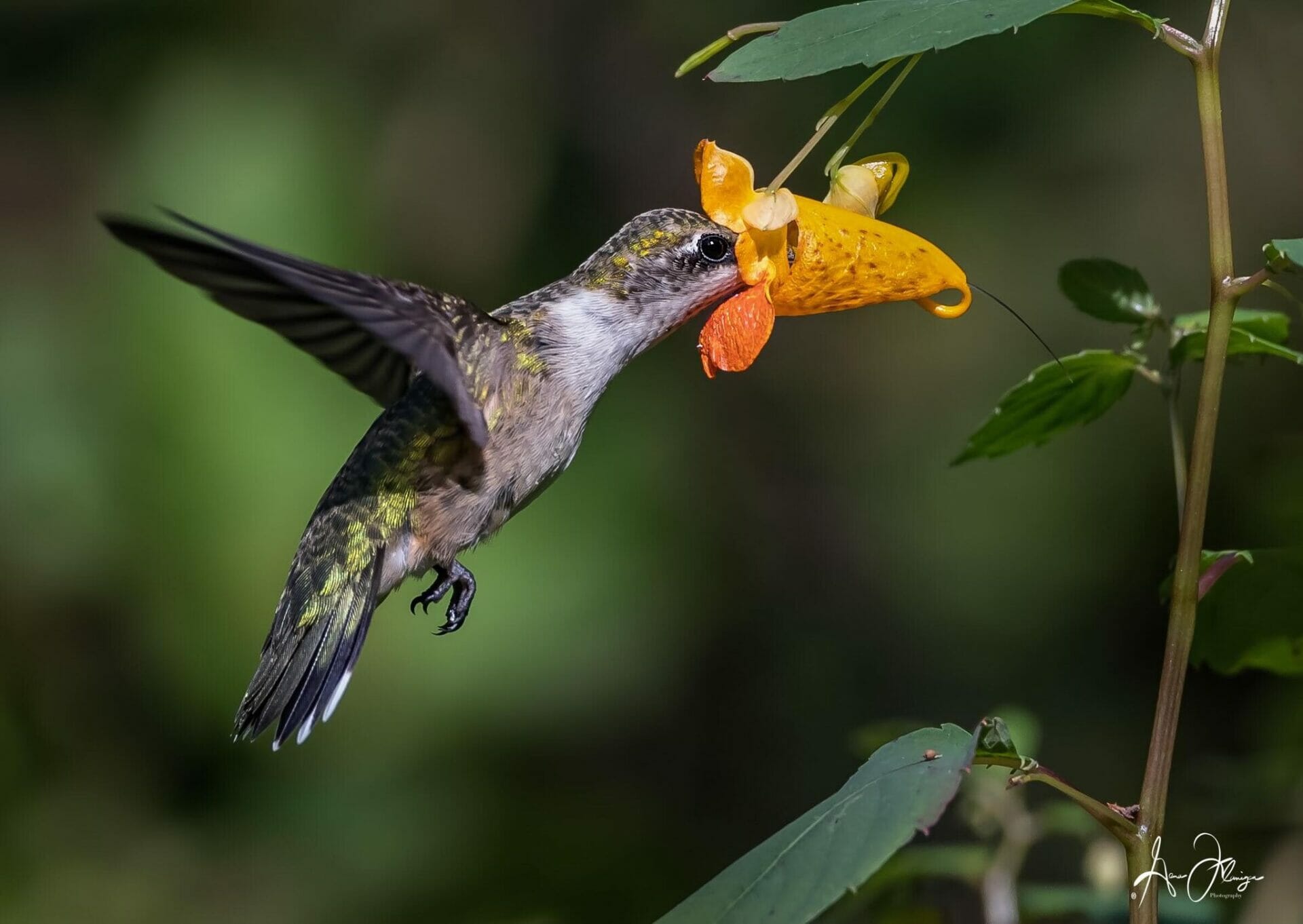 Ruby-throated hummingbird visiting orange jewelweed (Impatiens capensis). Photo by Gena Flanigen.
Annual plants don’t get as much attention as longer-lived plants like perennials, shrubs, trees, and vines. They do have an important role to play in the ecosystem, and our native species of Impatiens are no exception. People are often surprised to know that we have native Impatiens; they are quite taller than the annual bedding plant commonly known as impatiens. Still, they share characteristics of having succulent (juicy) stems and enjoying a preference for moist, part-shade areas.
Naturally, you’ll find our two species of Impatiens in moist-wet areas where their ability to create large amounts of seed, a common trait for annuals, allows them to create dense stands of vegetation, with plants 2-5 feet tall. These plants enhance streamside shade, provide nectar for hummingbirds and bees, as well as provide food for several moth caterpillars and critters that eat the seeds. Deer may browse on it. Its dense growth also helps to shade out weed species such as garlic mustard and stiltgrass.

Left: Orange jewelweed Impatiens capensis). Right: Pale jewelweed (Impatiens pallida).
In Georgia, orange jewelweed (Impatiens capensis) is the more widely distributed species while the pale jewelweed (I. pallida) is only found in the North Georgia Mountains. The flowers are conical in shape and are actually composed of 5 petals and 3 sepals (one sepal helps to form the nectar pouch). They dangle from thin pedicels. In addition to these flowers, the plant may also produce insignificant, cleistogamous flowers (self-pollinating) that produce fertile seed without the help of insects.
The common name jewelweed is thought to come from the shimmering look of the leaves when flecked with water; another name is touch-me-not, a reference to the spring-loaded action of seed pods that eject their ripe seeds when touched. Spotted jewelweed, another common name for the orange-colored species, refers to its red-flecked petals. Of course, many people know it as a poison ivy remedy. The juices from its stem can be made into a salve for itchy spots.
Since this plant is an annual, it is rarely found at plant sales. Friends who have it are often willing to share and seeds can be found online. Once you have it, you’ll find it popping up in new places where conditions are favorable. I’m finding it in a lot of my pots this year after having just one plant last year. The hummingbirds are really appreciating it!
Chapter News
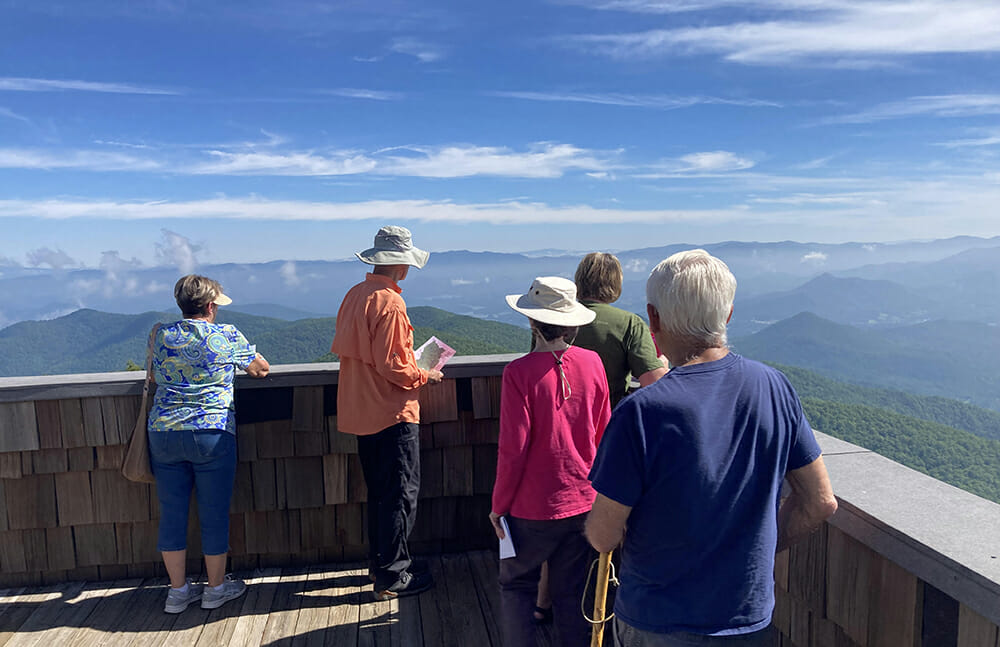
North Georgia Mountains Chapter members enjoyed the view from the highest point in Georgia.
North Georgia Mountains Chapter
The North Georgia Mountains Chapter has taken a break from our monthly meetings with presenters, in July opting for a field trip starting at the top of Brasstown Bald (the highest point in Georgia), led by Callie Moore with MountainTrue. At the top, we learned about the general definition of aquifers and specifically about the Upper Hiwassee River watershed as viewed from the observation platforms. A lot must be done to preserve the cleanliness and the natural communities served by these water basins. On the return walk down to the parking lot, we identified many of the native plants found at that elevation, and there was a final visit to the springhouse that serves the visitors’ center, with the water naturally coming up from lower elevation to emerge so high up mountain.
With so many people otherwise occupied it has been decided to take August off, and we will be starting our monthly presentations again in September, with Becky Griffin teaching us about pollinators on September 10th at Young Harris College.
Intown Atlanta Chapter
Pollinator Picnics - August 20:
The Intown Atlanta Chapter will be on site at various locations around town to support the University of Georgia Extension’s 2022 Great Georgia Pollinator Census. Join us to count the pollinators that are so vital to life on earth. We will have experts there to help you ID the plants and insects. We encourage counters of all ages to come out.
Learn more about the census in the article earlier in this issue. We encourage you to come out for the count and bring a picnic lunch to enjoy when you’ve finished counting.
Our representatives will be there between 10:00 a.m. and noon at locations throughout Atlanta including Mason Mill Park, Zonolite Park, GSU Perimeter College Native Plant Botanical Garden, and the Atlanta History Center. And it's free! Watch for updates on our announcement at the GNPS web site.
Annual Chapter Meeting:
Don't forget to mark your calendars for Sunday, September 18, 10 a.m. - noon and join Intown Chapter members for our Annual Chapter Meeting. The main event after the meeting will be an epic Native Plant Swap for newbie and seasoned native plant gardeners to share, learn, and talk plants. The Location is currently TBD, but as in 2021, we are aiming for a great outdoor location in a beloved neighborhood greenspace.
Coastal Plain Chapter
CPC member Heather Brasell of Alapaha was recently recognized at the Georgia Forestry Association Conference. The Murray H. Gaskins, Sr. Marital Trust, owned by Heather Brasell, has been selected as Georgia Outstanding Tree Farm of the Year by the American Tree Farm System.
Heather is the immediate past-president of the Coastal Plain Chapter and is a past-president of the Georgia Botanical Society. She currently serves on the GNPS Conservation and Education Committees. Heather also operates the Gaskins Forest Education Center in Alapaha, the site of many environmental education classes and research.
Representatives from the American Tree Farm System and Project Learning Tree produced an eight-minute video about Heather’s forestry operation. The video was presented at the Georgia Forestry Association Conference in Savannah on July 30, 2022.
Watch this video to learn more about Heather’s successful forestry operation that includes practices to support ecological diversity by controlled burning, elimination of invasive plants, protection of wildlife, and expansion of pollinator habitats. You’ll also learn more about the Gaskins Forest Education Center, where many native plant classes and events have been held.
Augusta's River Region Chapter
Augusta's River Region Chapter will be hosting a plant rescue on August 12th and 13th in Screven County. The goal is to rescue about a thousand plants that will be used in restorations in the Augusta area. If interested, RSVP to augusta@gnps.org.
We are also planning a garden tour for September. More info will be posted on our Facebook page and the GNPS calendar as the event comes together.
Fringed Campion Chapter
The Fringed Campion chapter, along with the Ocmulgee Audubon Society, Master Gardeners of Central Georgia, and all citizens interested in conserving Macon's biodiversity, are scheduled to talk with the Director of the Macon-Bibb County Parks & Beautification Department, Mr. Mike Glisson on August 17 at 6:00 p.m. The meeting will be held at Bibb County Extension Office, 715 Oglethorpe Street, Macon, GA. He will share how MBC achieved Tree City USA status, and how we can contribute to protecting our biodiversity and ecosystem using the eco-friendly landscaping practices outlined in the State Botanical Garden's Connect to Protect program. The event is open to the public. .
|